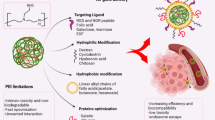Abstract
The objective of this study was to evaluate the possibility of using GE11–polyethylene glycol–polyethylenimine (GE11-PEG-PEI) for targeted gene delivery to treat epidermal growth factor receptor (EGFR)-overexpressing laryngeal cancer. This study described the design, characterization, and in vitro and in vivo study of the nanocarrier GE11-PEG-PEI for gene delivery to treat laryngeal cancer. Analysis of the sizes and zeta potentials indicated that the formation of PEGylated complexes was dependent on the N/P ratio, and these complexes were capable of binding plasmid DNA and condensing DNA into small positively charged nanoparticles. The results also revealed that GE11-PEG-PEI had a weaker effect on cell survival in vitro. Gene transfection was performed on human laryngeal cancer Hep-2 cells in vitro and in vivo. Both the in vitro and in vivo results demonstrated that GE11-PEG-PEI had greater transfection efficiency than mPEG-PEI. Compared with mPEG-PEI/pORF-hTRAIL and saline, GE11-PEG-PEI/pORFh-TRAIL significantly (p < 0.05) reduced tumor growth in nude mice with laryngeal cancer. Moreover, the GE11-PEG-PEI/pORF-hTRAIL-treated groups showed more apoptosis than the mPEG-PEI/pORF-hTRAIL-treated groups. Therefore, our results showed that the peptide GE11 conjugated to PEG-PEI delivered significantly more genes to EGFR-overexpressing laryngeal cancer cells in vivo, indicating that GE11-PEG-PEI may be a suitable gene vector for treating EGFR-overexpressing laryngeal cancer.




Similar content being viewed by others
References
Kamimura K, Suda T, Zhang G, Liu D. Advances in gene delivery systems. Pharmaceut. Med. 2011;25(5):293–306.
Boussif O, Zanta MA, Behr JP. Optimized galenics improve in vitro gene transfer with cationic molecules up to 1000-fold. Gene Ther. 1996;3(12):1074–80.
Sonawane ND, Szoka FC Jr, Verkman AS. Chloride accumulation and swelling in endosomes enhances DNA transfer by polyamine-DNA polyplexes. J Biol Chem. 2003;278(45):44826–31.
Lee M, Kim SW. Polyethylene glycol-conjugated copolymers for plasmid DNA delivery. Pharm Res. 2005;22(1):1–10.
Bruzzese F, Leone A, Rocco M, Carbone C, Piro G, Caraglia M, Budillon A, et al. HDAC inhibitor vorinostat enhances the antitumor effect of gefitinib in squamous cell carcinoma of head and neck by modulating ErbB receptor expression and reverting EMT. J Cell Physiol. 2011;226(9):2378–90.
Wang JL, Tang GP, Shen J, Hu QL, Xu FJ, Wang QQ, et al. A gene nanocomplex conjugated with monoclonal antibodies for targeted therapy of hepatocellular carcinoma. Biomaterials. 2012;33(18):4597–607.
Li Z, Zhao R, Wu X, Sun Y, Yao M, Li J, et al. Identification and characterization of a novel peptide ligand of epidermal growth factor receptor for targeted delivery of therapeutics. FASEB J. 2005;19(14):1978–85.
Milane L, Duan Z, Amiji M. Therapeutic efficacy and safety of paclitaxel/lonidamine loaded EGFR-targeted nanoparticles for the treatment of multi-drug resistant cancer. PLoS ONE. 2011;6(9):24075–86.
Ren H, Gao C, Zhou L, Liu M, Xie C, Lu W. EGFR-targeted poly (ethylene glycol)-distearoylphosphatidylethanolamine micelle loaded with paclitaxel for laryngeal cancer: preparation, characterization and in vitro evaluation. Drug Deliv. 2014;. doi:10.3109/10717544.2014.896057.
Wang J, Lei Y, Xie C, Lu W, Yan Z, Gao J, et al. Targeted gene delivery to glioblastoma using a C-end rule RGERPPR peptide-functionalised polyethylenimine complex. Int J Pharm. 2013;458(1):48–56.
Al-Dosari MS, Gao X. Nonviral gene delivery: principle, limitations, and recent progress. AAPS J. 2009;11(4):671–81.
Evans CH, Huard J. Gene therapy approaches to regenerating the musculoskeletal system. Nat Rev Rheumatol. 2015;11(4):234–42.
Nishikawa M, Hashida M. Nonviral approaches satisfying various requirements for effective in vivo gene therapy. Biol Pharm Bull. 2002;25(3):275–83.
Lei Y, Wang J, Xie C, Wagner E, Lu W, Li Y, et al. Glutathione-sensitive RGD-poly (ethylene glycol)-SS-polyethylenimine for intracranial glioblastoma targeted gene delivery. J Gene Med. 2013;15(8–9):291–305.
Nguyen J, Xie X, Neu M, Dumitrascu R, Reul R, Sitterberg J, et al. Effects of cell-penetrating peptides and pegylation on transfection efficiency of polyethylenimine in mouse lungs. J Gene Med. 2008;10(11):1236–46.
Petersen H, Fechner PM, Martin AL, Kunath K, Stolnik S, Roberts CJ, et al. Polyethylenimine-graft-poly (ethyleneglycol) copolymers: influence of copolymer block structure on DNA complex-ation and biological activities as gene delivery system. Bioconjug Chem. 2002;13(4):845–54.
Master A, Malamas A, Solanki R, Clausen DM, Eiseman JL, Sen Gupta A. A cell-targeted photodynamic nanomedicine strategy for head and neck cancers. Mol Pharm. 2013;10(5):1988–97.
Prabaharan M. Chitosan-based nanoparticles for tumor-targeted drug delivery. Int J Biol Macromol. 2015;72:1313–22.
Oh KS, Lee H, Kim JY, Koo EJ, Lee EH, Park JH, et al. The multilayer nanoparticles formed by layer by layer approach for cancer-targeting therapy. J Control Release. 2013;165(1):9–15.
Kwon IK, Lee SC, Han B, Park K. Analysis on the current status of targeted drug delivery to tumors. J Control Release. 2012;164(2):108–14.
Gratton SE, Ropp PA, Pohlhaus PD, Luft JC, Madden VJ, Napier ME, et al. The effect of particle design on cellular internalization pathways. Proc Natl Acad Sci USA. 2008;105(33):11613–8.
Acknowledgments
This study was financially supported by National Natural Science Foundation of China (No. 81001200) and School of Pharmacy, Fudan University & The Open Project Program of Key Lab of Smart Drug Delivery (Fudan University), Ministry of Education, China.
Conflict of interest
The authors declare no conflict of interest.
Ethical standard
All applicable international, national, and/or institutional guidelines for the care and use of animals were followed.
Author information
Authors and Affiliations
Corresponding author
Rights and permissions
About this article
Cite this article
Ren, H., Zhou, L., Liu, M. et al. Peptide GE11–Polyethylene Glycol–Polyethylenimine for targeted gene delivery in laryngeal cancer. Med Oncol 32, 185 (2015). https://doi.org/10.1007/s12032-015-0624-9
Received:
Accepted:
Published:
DOI: https://doi.org/10.1007/s12032-015-0624-9




